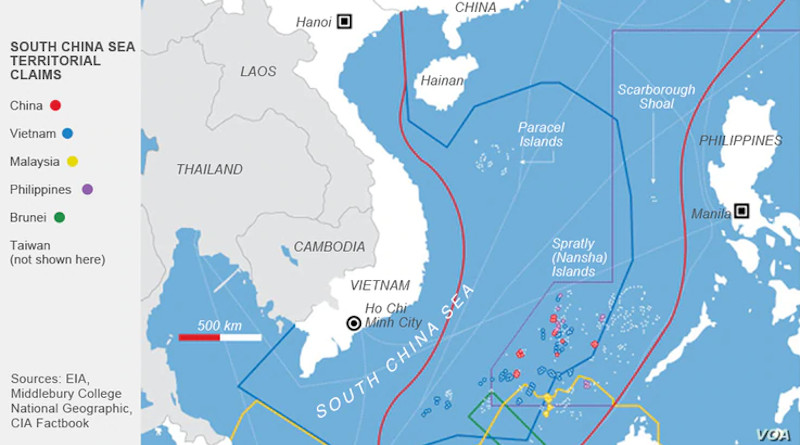Chinese Survey Ship Spotted Off Coast Of Central Vietnam
By BenarNews
By Drake Long*
China has sent a survey ship with a Coast Guard escort into Vietnamese waters of the South China Sea, ship tracking data show.
Vietnam has yet to react publicly to the deployment, but it comes at a diplomatically sensitive time.
The new prime minister of Japan is set to visit Vietnam next week, and the Nikkei newspaper reported Wednesday that Japan is planning to sell defense equipment to Vietnam – a move that is likely to be opposed by China, which views Japan as a strategic rival.
The Shiyan-1 survey and research ship departed Haikou Bay, in China’s Hainan province, on Monday and came within 70 nautical miles of Vietnam’s Quang Ngai province on Tuesday, according to data reviewed by Radio Free Asia, a sister entity of BenarNews. As of Wednesday morning, it was 78 nautical miles off the coast of Binh Dinh province. Both areas are along Vietnam’s central coast.
The Shiyan-1 survey ship is operated by the Institute for Acoustics, a research center specializing in underwater acoustics for the Chinese Academy of Sciences, according to the International Maritime Organization database. Notably, it was expelled from the Eastern Indian Ocean by India’s navy back in December 2019 under suspicion of mapping the topography of the ocean floor for military purposes.
The China Coast Guard ship numbered 2305 followed the Shiyan-1 into Vietnamese waters on Monday, but has since left its side. Ship-tracking data from Wednesday morning shows it sailing in the opposite direction of the research ship, back to Hainan.
The data shows five ships operated by Vietnam’s Fisheries Resources Surveillance – a maritime law enforcement agency separate from that country’s coastguard – appear to have monitored both the CCG and Shiyan-1 survey ship as they traveled into Vietnam’s exclusive economic zone, or EEZ. A country’s EEZ extends 200 nautical miles beyond their coastlines and provides them certain resource rights to the waters there.
China has often deployed survey ships into the waters of other nations in the South China Sea, in what is widely interpreted as an assertion of its claim to “historic rights” over nearly all of the disputed waterway.
Six other Asian governments have territorial claims or maritime boundaries in the South China Sea that overlap with the sweeping claims of China. They are Brunei, Indonesia, Malaysia, the Philippines, Taiwan and Vietnam. While Indonesia does not regard itself as party to the South China Sea dispute, Beijing claims rights to parts of that sea overlapping Indonesia’s EEZ.
RFA spotted the Shiyan-1 on July 16 conducting a survey straddling nearly 330 nautical miles over a broad swathe of the Paracel Islands, an archipelago of rocks and reefs in the northern half of the South China Sea which is also claimed by Vietnam and Taiwan. It subsequently sailed to an area roughly 230 nautical miles from Chichijima, a remote Japanese island located far to the east of Japan, and performed a survey there until Aug. 24.
On the diplomatic front Wednesday, Japan voiced concern over developments in the South China Sea at the start of annual talks between Japan and the Association of Southeast Asian Nations. This year, the talks took place virtually.
Both sides emphasized freedom of navigation in and overflight over the disputed waters, according to an ASEAN press release. Japan’s Deputy Minister for Foreign Affairs Mori Takeo “underlined the importance of peace and stability in the region, expressing concerns over recent developments in the East Sea,” in his remarks to ASEAN, according to Vietnamese state media. East Sea is Vietnam’s term for the South China Sea.
Japan’s Prime Minister Suga Yoshihide, who took office just a month ago, called his Vietnamese counterpart Nguyen Xuan Phuc on Monday to plan for his upcoming visit to Vietnam amid signs that Tokyo is stepping up its engagement in the security realm in Southeast Asia.
“Japan will work with various nations to realize a free and open Indo-Pacific region. That’s the idea we have,” Chief Cabinet Secretary of Japan Kato Katsunobu said at a press conference Wednesday morning.
This week, Japan’s Maritime Self-Defense Force is conducted drills in the South China Sea with the U.S. Navy. And at the weekend, Japan conducted an anti-submarine warfare drill of its own in the South China Sea, and then made a port call at Vietnam’s Cam Ranh Bay.
China looked dimly on Japan’s submarine maneuvers. Foreign Ministry spokesman Zhao Lijian told reporters in Beijing on Monday: “We hope that the relevant country will not do things detrimental to regional peace, security and stability.”
Those comments came as China’s top diplomat conducted a five-nation tour of Southeast Asia this week, visiting Cambodia, Malaysia, Laos, Thailand, and Singapore, although not Vietnam.
Minister of Foreign Affairs Wang Yi used the occasion to blast the ‘Quad,’ a grouping of four Indo-Pacific democracies that includes Japan, Australia, India, and the United States.
“What [the Quad] pursues is to trumpet the old-fashioned Cold War mentality, and to stir up confrontation among different groups and blocs, and to start a geopolitical competition,” he said at a press conference in Kuala Lumpur. “In this sense, the strategy itself is a security risk. If it is forced forward it will wind back the clock of history.”

